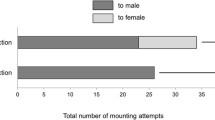Abstract
The bolas spider,Mastophora hutchinsoni, attracts adult males of four species of nocturnally active Lepidoptera through aggressive chemical mimicry of those species' sex pheromones. Here we report the identification of the sex pheromone of one prey species, the smoky tetanolita (Tetanolita mynesalis). In sex pheromone gland extracts, only two peaks stimulated an electrophysiological response as measured by a coupled gas chromatography-electroantennographic detection analysis. These two peaks had retention times identical to (3Z,6Z,9Z)-heneicosatriene (3Z,6Z,9Z-21:H) and (3Z,9Z)-cis-6,7-epoxy-heneicosadiene (3Z,9Z-cis-6,7-epoxy-21:H), respectively, and mass spectra identical to these two compounds. It was determined that 0.23±0.16 and 0.56±0.26 ng of 3Z,6Z,9Z-21:H and 3Z,9Z-cis-6,7-epoxy-21:H, respectively, were present in pheromone gland extracts from individual females. A 1:1 blend of 3Z,6Z,9Z-21:H and 3Z,9Z-6S,7R-epoxy-21:H was an effective attractant for adult males from feral populations. Blend ratios of these two components from 2:1 to 1:2 were equally effective as attractants. Greater deviation from the optimal blends resulted in diminished trap catches. The enantiomer 3Z,9Z-6R,7S-epoxy-21:H not only was not effective in attracting males, its presence in the effective blend shut down trap catches. These results indicate that the pheromone blend consists of 3Z,6Z,9Z-21:H and 3Z,9Z-6S,7R-epoxy-21:H. This is the first report of a hydrocarbon/epoxide pheromone for a prey species of this bolas spider. Sex attractants or pheromones for the other three prey species are composed of aldehydes or acetates.
Similar content being viewed by others
References
Arn, H., Tóth, M., andPriesner, E. 1992. List of Sex Pheromones of Lepidoptera and Related Attractants, 2nd ed., International Organization for Biological Control, Montfavet, France.
Clark, J.D., andHaynes, K.F. 1990. Sex attractant for the bluegrass webworm (Lepidoptera: Pyralidae).J. Econ. Entomol. 83:856–859.
Covell, C.V., Jr. 1984. A Field Guide to the Moths of Eastern North America. Houghton Mifflin, Boston.
Eberhard, W.G. 1977. Aggressive chemical mimicry by a bolas spider.Science 198:1173–1175.
Haynes, K.F. 1990. Identification of sex pheromone of bristly cutworm,Lacinipolia renigera (Stephens).J. Chem. Ecol. 16:2615–2621.
Leal, W.S., Mochizuki, F., Wakamura, S., andYasuda, T. 1992. Electroantennographic detection ofAnomala cuprea Hope (Coleoptera: Scarabaeidae) sex pheromone.Appl. Entomol. Zool. 27:289–291.
Millar, J.G., andUnderhill, E.W. 1986. Synthesis of chiral bis-homoallylic epoxides. A new class of lepidopteran sex attractants.J. Org. Chem. 51:4726–4728.
Millar, J.G., Giblin, M., Barton, D., andUnderhill, E.W. 1991. Synthesis and field screening of chiral monounsaturated epoxides as lepidopteran sex attractants and sex pheromone components.J. Chem. Ecol. 17:911–929.
Mosher, E. 1969. Lepidoptera Pupae. Entomological Reprint Specialists, East Lansing, Michigan.
Pringle, J.W.S. 1938. Proprioception in insects I. A new type of mechanical receptor from the palps of the cockroach.J. Exp. Biol. 15:101–113.
Stowe, M.K. 1988. Chemical mimicry, pp. 513–580,in K.C. Spencer (ed.). Chemical Mediation of Coevolution. Academic Press, San Diego.
Stowe, M.K., Tumlinson, J.H., andHeath, R.R. 1987. Chemical mimicry: Bolas spiders emit components of moth prey species sex pheromones.Science 236:964–967.
Struble, D.L., andArn, H. 1984. Combined gas chromotography and electroantennogram recording of insect olfactory responses, pp. 161–178,in H.E. Hummel and T.A. Miller (eds.). Techniques in Pheromone Research. Springer-Verlag, New York.
Tóth, M., Buser, H.R., Guerin, P.M., Arn, H., Schmidt, F., Francke, W., andSzöcs, G. 1992.Abraxas grossulariata L. (Lepidoptera: Geometridae): Identification of (3Z,6Z,9Z)-3,6,9-heptadecatriene and (6Z,9Z)-6,9-cis-3,4-epoxyheptadecadiene in the female sex pheromone.J. Chem Ecol. 18:13–25.
Underhill, E.W., Chisholm, M.D., andSteck, W. 1977. Olefinic aldehydes as constituents of sex attractants for noctuid moths.Environ. Entomol. 6:333–337.
Underhill, E.W., Palaniswamy, P., Abrams, S.R., Bailey, B.K., Steck, W.F., andChisholm, M.D. 1983. Triunsaturated hydrocarbons, sex pheromone components ofCaenurgina erechtea.J. Chem. Ecol. 9:1413–1423.
Wong, J.W., Underhill, E.W., MacKenzie, S.L., andChisholm, M.D. 1985. Sex attractants for geometrid and noctuid moths: field trapping and electroantennographic responses to triene hydrocarbons and monoepoxydiene derivatives.J. Chem. Ecol. 11:727–756.
Yeargan, K.V. 1988. Ecology of a bolas spider.Mastophora hutchinsoni: Phenology, hunting tactics, and evidence for aggressive chemical mimicry.Oecologia (Berlin) 74:524–530.
Yeargan, K.V. 1994. Biology of bolas spiders.Annu. Rev. Entomol. 39:81–99.
Author information
Authors and Affiliations
Rights and permissions
About this article
Cite this article
Haynes, K.F., Yeargan, K.V., Millar, J.G. et al. Identification of sex pheromone ofTetanolita mynesalis (Lepidoptera: Noctuidae), a prey species of bolas spider,Mastophora hutchinsoni . J Chem Ecol 22, 75–89 (1996). https://doi.org/10.1007/BF02040201
Received:
Accepted:
Issue Date:
DOI: https://doi.org/10.1007/BF02040201




